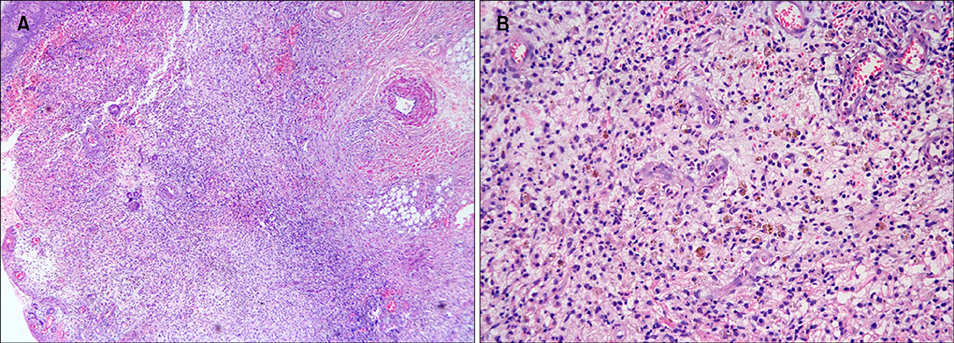Ann Dermatol.
2017 Aug;29(4):476-478. 10.5021/ad.2017.29.4.476.
Pyoderma Gangrenosum in a Patient with X-Linked Agammaglobulinemia
- Affiliations
-
- 1Ministry of Education Key Laboratory of Child Development and Disorders, Key Laboratory of Pediatrics in Chongqing, Chongqing, China.
- 2Chongqing International Science and Technology Cooperation Center for Child Development and Disorders, Chongqing, China.
- 3Department of Dermatology, Children's Hospital of Chongqing Medical University, Chongqing, China. huawangpfk@163.com
- KMID: 2388947
- DOI: http://doi.org/10.5021/ad.2017.29.4.476
Abstract
- X-linked agammaglobulinemia (XLA) is a primary immunodeficiency disorder caused by germline mutations of B-cell tyrosine kinase (BTK) gene. It is characterized by decreased serum immunoglobulins levels and circulating mature B cells. This defect in humoral immunity leads to increased susceptibility to infection. Pyoderma gangrenosum (PG) is an uncommon, ulcerating, neutrophilic dermatosis. Here we report PG in an 8-year-old patient with XLA. The patient received intravenous immunoglobulin treatment in conjunction with prednisone and topical application of 0.03% tacrolimus ointment and the ulcer was almost completely healed in the 2 weeks of follow-up. The coexistence has been rarely reported. XLA may be a possible cofactor in the pathogenesis of PG.
MeSH Terms
Figure
Reference
-
1. Bruton OC. Agammaglobulinemia. Pediatrics. 1952; 9:722–728.
Article2. Dua J, Elliot E, Bright P, Grigoriadou S, Bull R, Millar M, et al. Pyoderma gangrenosum-like ulcer caused by Helicobacter cinaedi in a patient with x-linked agammaglobulinaemia. Clin Exp Dermatol. 2012; 37:642–645.
Article3. Conley ME, Rohrer J, Minegishi Y. X-linked agammaglobulinemia. Clin Rev Allergy Immunol. 2000; 19:183–204.
Article4. Jefferies CA, Doyle S, Brunner C, Dunne A, Brint E, Wietek C, et al. Bruton's tyrosine kinase is a Toll/interleukin-1 receptor domain-binding protein that participates in nuclear factor kappaB activation by Toll-like receptor 4. J Biol Chem. 2003; 278:26258–26264.
Article5. Van der, Smits BW, van der Meer JW. Hypogammaglobulinaemia: cumulative experience in 49 patients in a tertiary care institution. Neth J Med. 2002; 60:140–147.6. Barrière H, Litoux P, Stalder JF, Berger M, Delahaye M. Pyoderma gangrenosum associated with congenital hypogammaglobulinemia. Ann Dermatol Venereol. 1979; 106:695–696.7. Bloom D, Fisher D, Dannenberg M. Pyoderma gangrenosum associated with hypogammaglobulinemia; report of two cases. AMA Arch Derm. 1958; 77:412–421.
Article8. Marcussen PV. Hypogammaglobulinemia in pyoderma gangrenosum. J Invest Dermatol. 1955; 24:275–280.
Article9. Schwartzfarb EM, Weir D, Conlan WA, Romanelli P, Kirsner RS. Pyoderma gangrenosum in a patient with Bruton's X-linked agammaglobulinemia: shared pathogenesis of altered tumor necrosis factor alpha? J Clin Aesthet Dermatol. 2008; 1:26–29.10. Adachi Y, Kindzelskii AL, Cookingham G, Shaya S, Moore EC, Todd RF 3rd, et al. Aberrant neutrophil trafficking and metabolic oscillations in severe pyoderma gangrenosum. J Invest Dermatol. 1998; 111:259–268.
Article11. Necas M, Semrádova V, Vaskù V. Pyoderma gangraenosum associated with autoimmune thyreopathy and hyperandrogenic syndrome. Acta Dermatovenerol Alp Pannonica Adriat. 2005; 14:57–60.12. Cafardi J, Sami N. Intravenous immunoglobulin as salvage therapy in refractory pyoderma gangrenosum: report of a case and review of the literature. Case Rep Dermatol. 2014; 6:239–244.
Article13. Charles CA, Leon A, Banta MR, Kirsner RS. Etanercept for the treatment of refractory pyoderma gangrenosum: a brief series. Int J Dermatol. 2007; 46:1095–1099.
Article14. Deckers-Kocken JM, Pasmans SG. Successful tacrolimus (FK506) therapy in a child with pyoderma gangrenosum. Arch Dis Child. 2005; 90:531.
Article
- Full Text Links
- Actions
-
Cited
- CITED
-
- Close
- Share
- Similar articles
-
- A Case of Behcet's Disease Associated with Pyoderma Gangrenosum
- A Case of Pyoderma Gangrenosum Occurring in Behcet's Disease
- A Case of Pyoderma Gangrenosum Associated with Acute Leukemia
- A Case of Post-traumatic Pyoderma Gangrenosum Associated with Ulcerative Colitis
- Bullous Pyoderma Gangrenosum in a Child



